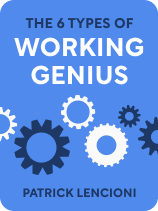

This article is an excerpt from the Shortform book guide to "The 6 Types of Working Genius" by Patrick Lencioni. Shortform has the world's best summaries and analyses of books you should be reading.
Like this article? Sign up for a free trial here.
Has your team been underperforming? How can you improve team performance?
Teams work best when employees are bouncing off each other. In The 6 Types of Working Genius, Patrick Lencioni explains that it’s a manager’s job to identify the team members’ types of intelligence and organize them to optimize performance.
Here’s how to improve team performance and get the most out of the workday.
Genius, Competency, and Frustration
According to Lencioni, the best way to know how to improve team performance is by learning where your team members excel. The average individual excels in two of the six forms of intelligence. For the other four, she is competent or proficient at two, and she is frustrated or drained by two.
Proficiency means a short-term ability to perform that task. People may be able to use their proficient intelligences when the team experiences shortfalls with related tasks, but when they do so for an extended time, they become exhausted and irritated. Work quality and morale eventually suffer.
The intelligences that drain a person are those that require tasks they struggle with. If your teammates hold authority over tasks that drain them, Lencioni says it will harm their professional happiness and the work’s successful outcome. Additionally, the rest of the team may misinterpret the person’s failure as being the result of low motivation, team spirit, ability, or the like, when in reality it’s due to their being less naturally inclined to that form of labor.
| Gone With Red Tape In distinguishing between the categories of Genius, Competence, and Frustration, Lencioni highly values a supervisor’s ability to perceive different intelligences operating within her team. This expectation is part of a broader trend in business literature that seeks to portray modern leaders as more orchestrators of talent than dictators of process. One reason for this might be that bureaucracy, which tends to favor top-down organization and direction, tends to stifle creativity and hamper process, as Gary Hamel and Michele Zanini explain in Humanocracy. On the contrary, if leaders enable individuals to pursue their own goals and determine a larger portion of their own processes, the organization will benefit. For example, to avoid bureaucratic smothering, a company might consistently encourage individuals to explore new work territories and increase the level of accountability they accept, for both successes and failures. They may also push team members to have more regular encounters with customers, which allows them to see the impact they’re having on other people’s lives through their work. |
Balanced teams recognize a person’s skill levels across all three categories, allotting tasks and leadership accordingly. To this end, team managers must strive to create transparency regarding what teammates’ competencies and frustrations are. Put differently, employees should feel safe offering feedback regarding the types of work that most drain and discourage them. Indeed, Lencioni insists these deficits are natural to any individual’s range of abilities—just as their intelligences are.
(Shortform note: Some organizations may experience difficulty applying Lencioni’s model if it absolves team members of the need to observe hierarchy as a necessary feature of leadership. In The Culture Map, Erin Meyer argues that values such as leadership through consensus tend to resonate more effectively in societies and organizations where egalitarianism and individualism are also valued, as is common in the West. However, this approach is often deemed less desirable, even destabilizing, in communities where top-down structure and obedience are more highly prized, such as in parts of Asia, where every team member will likely not feel comfortable voicing all opinions or personal preferences.)
Genius and Overall Organizational Health
Lencioni argues that the implementation of his model will lead to dramatic improvements in your team’s performance, particularly in areas of leadership, productivity, employee retention/morale, and meeting integrity.
The Benefits of Recognizing Genius
First, leadership that follows an intelligence-based approach leads far more organically; it’s better poised to tap into the resources right at its fingertips. It doesn’t shoehorn people into boilerplate job descriptions; rather, it encourages people to follow their talents instead of conventions. Lencioni identifies the following chief benefits for any organization:
- People don’t feel forced to be good at all things, all the time; this means they can focus primarily on the things at which they’re best.
- Team members have greater insights into everyone’s strengths and weaknesses. And instead of blaming one another for those gaps, they embrace them as a natural function of any team.
- Productivity and efficiency increase accordingly.
| Parts of the Whole Lencioni concludes that leaders who embrace his intelligence model not only produce teams that are more cohesive, but that also contain members who are more willing to go above and beyond for the success of mutual endeavors. In Extreme Ownership, Jocko Willink and Leif Babin agree on the importance of individual team members understanding their role within the broader scheme of things, as well as the specific tasks they answer for. According to Willink and Babin, this recognition of the purpose and justification behind team members’ specific roles builds trust in leadership, lessens ego, and pushes individuals towards enhanced ownership of the results they produce. Moreover, this sense of ownership over a specific portion of the work process frees individuals to make more intuitive and on-the-spot decisions in their particular arena, also allowing those higher in the leadership structure greater room to focus on big-picture concerns. Assuredly, Willink and Babin’s model depends much more on an assumption of hierarchy than is obvious in Lencioni’s collaboration between intelligences. |
The benefits are just as striking, Lencioni continues, for employees themselves, as well as for how ensuing morale reflects upon the company. Employees who regularly engage their intelligences and avoid tasks for which they’re less equipped are simply happier. They exude more enthusiasm, stay on the job longer, and the company acquires a reputation as a great place to work.
Keeping Your Key People
Lencioni argues that allowing employees to tap into their natural strengths and apply them meaningfully to group outcomes is a critical component of employee retention. However, research suggests that the primary driver of such retention may be more obvious – for example, one result shows that, as of 2022, 65% of individuals leaving a current job are simply seeking enhanced salary opportunities.
Other areas you can focus on to boost employee retention include:
- Emphasis on the quality of hiring and onboarding processes
- Wellness options and other perks
- Continuous feedback, professional development, and mentorship options
- Flexibility (i.e. blends of on-site and remote work) and prioritization of work-life balance

———End of Preview———
Like what you just read? Read the rest of the world's best book summary and analysis of Patrick Lencioni's "The 6 Types of Working Genius" at Shortform.
Here's what you'll find in our full The 6 Types of Working Genius summary:
- The six types of working intelligence that successful teams need
- How to identify which traits your team members have
- How to apply the six types of genius to bolster workflow and well-being






